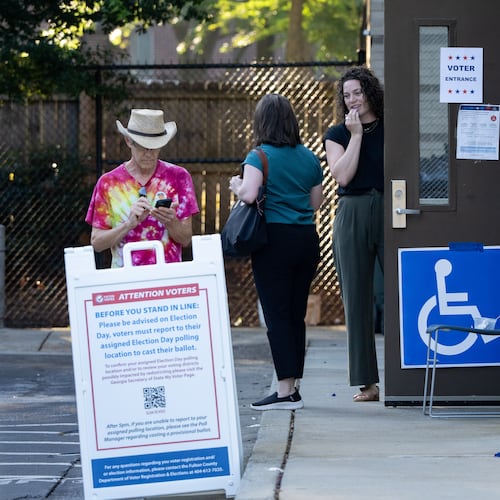It seemed almost poetic to many Georgia Democrats that the party’s presidential debate shifts next month from Ohio to the Peach State, bringing with it all the attendant attention and exposure that comes with hosting a major political event.
After all, state Democratic leaders have been beating the drum for years now urging national operatives to pull resources away from Ohio and toward Georgia and other Sun Belt states. To them, the Nov. 20 debate only puts an exclamation mark on their insistence on a southward shift.
Reinforced by an exodus of Ohio Democrats who are now in prominent roles in Georgia, state Democrats are pressing the case that Georgia, with a more diverse population and tightening state elections, holds far more promise than Midwestern states.
“All roads to the White House will go through Georgia,” Atlanta Mayor Keisha Lance Bottoms said. “Our electorate is uniquely representative of the nation at large, and we provide more untapped opportunity than most other states.”
They’re battling history to make their case. Ohio is an iconic bellwether in U.S. politics, with a track record of voting for the presidential victor 29 times in the past 31 elections. The state’s electoral votes clinched victory for George W. Bush in 2004 and helped put Donald Trump over the top three years ago.
In that 2016 race, both parties flooded the state with more than $100 million in spending, but polls showed Trump carving out a solid lead weeks before the election. He easily captured Ohio with an 8-point victory — he only won by 5 points in Georgia.
Still, Ohio Democrats point to signs of recent success, including U.S. Sen. Sherrod Brown’s dominant re-election win and the flip of a half-dozen legislative seats in 2018. They like to say that Trump is obsessed with the state, since he’s visited Ohio a dozen times since taking office.
“He knows that when Ohio turns blue, that’s the end of his presidency. That’s it,” said David Pepper, the Ohio Democratic Party’s chairman. “And guess what? He’s right. He is in trouble here. He’s in deep trouble. And we’ll be the state that ends the Trump presidency.”
Credit: Alyssa Pointer
Credit: Alyssa Pointer
‘The new Ohio?’
The tug of war between Ohio and Georgia mirrors a broader debate. Some party strategists say Democrats should focus on wooing white voters in the Rust Belt who helped Trump win Ohio, Michigan and Wisconsin rather than investing in Southern states where Republicans have dominated.
Georgia’s 2018 election gave the Sun Belt advocates an extra kick. Stacey Abrams came within 1.5 percentage points of an upset victory over Republican Brian Kemp by building a coalition of nonwhite voters, many who often skipped midterm elections, and white residents from the cities and suburbs.
And Democrats paved a blue path across Atlanta’s northern suburbs, flipping about a dozen state legislative seats and powering Lucy McBath to victory in Georgia’s 6th Congressional District. In Ohio, meanwhile, Brown won another term but Republicans won every other constitutional office.
“Georgia is the new Ohio. Both Georgia and Ohio had governor’s races last year, and you know where Democrats performed strongest? Right here,” said Tharon Johnson, who was the Southern regional director for Barack Obama’s 2012 presidential campaign. “With an energized electorate and two U.S. Senate seats up for grabs next year, Georgia is the swing state to win.”
Few know the situation as well as Lauren Groh-Wargo, who led the Ohio Democratic Party’s coordinated campaign from 2009 to 2011.
Now the top aide to Abrams, she penned a widely read memo to presidential candidates and national party operatives noting that national Democrats spent $70 million in Ohio in 2016 and fared worse than in Georgia, where Democrats spent just $8 million.
“This is not to say that national 2020 efforts should not also invest in perennial battlegrounds,” she wrote, “rather, it is a demonstration of the strategic imperative to include Georgia in the mix.”
An analysis of the 2016 electorate by the left-leaning Center for American Progress points to why Georgia, with its 16 electoral votes, might be more demographically pleasing for Democrats than Ohio and its 18 electoral votes. Key differences between the two states included their shares of white voters without college degrees, who tend to lean Republican, as well as nonwhite voters.
It found that Ohio’s electorate in the 2016 election was 57% white without a college degree, 28% white with a college degree and 16% nonwhite. By contrast, the same analysis found Georgia’s electorate during the last presidential contest was 38% white without a college degree, 24% white with a college degree and about 38% nonwhite.
“Our drumbeat from Georgia is about Georgia, the trajectory of the margins and registration numbers and demographics in Georgia, and how Georgia is winnable in 2020,” said Seth Bringman, a former Ohio Democratic Party official who is now a top Abrams deputy.
“We don’t disparage other states. Ohio continues to elect Sherrod Brown,” Bringman said. “We just point to hard data that show why Democrats must invest in Georgia.”
Credit: HYOSUB SHIN / AJC
Credit: HYOSUB SHIN / AJC
‘We will win’
Some special-interest groups have already pivoted. Priorities USA, a Democratic super PAC, flooded Ohio with TV ads the past two presidential cycles. But this year, the group said Ohio isn't among its top priorities — and that Georgia and other once-forbidding states are.
That’s not to say that Democrats are abandoning ship, or else the party wouldn’t have held the October presidential debate in the suburb of Westerville, a formerly conservative-leaning area where the party has made recent inroads. And Abrams is headed to Cleveland on Saturday to boost her Fair Fight voting rights group.
Still, even the symbolic nature of a Democratic debate in once-Republican territory offered a reminder of the challenges the party faces in winning over more suburban territory.
"The problem for Democrats in Ohio is that there aren't enough places in the state that look like Westerville and are trending Democratic to make up for the many more places that don't look like Westerville and are trending Republican," said Kyle Kondik, a University of Virginia political scientist who wrote a book, "Bellwether," about Ohio's political history.
In a lengthy analysis, he concluded that the state remains competitive, but it's "far more important now to Republicans than Democrats."
Georgia, too, is seen as a must-win for Republicans in 2020 — and perhaps a luxury for Democrats seeking to broaden their map. Party leaders in Atlanta grumbled about a lack of national investment before landing the November showdown, and they have pressed Democratic National Committee Chairman Tom Perez to make the state a priority.
If a strategy shift is in the works, Perez is not signaling much publicly. At an Ohio Democratic fundraiser shortly before the Westerville debate, he mocked Trump’s frequent visits to the state.
“Ohio is a battleground state and it is a battleground state that we will win,” Perez told the crowd. “But we have a lot of work to do.”
About the Author
Keep Reading
The Latest
Featured

![11/01/2018 -- Marietta, Georgia -- Oprah Winfrey[cq] (Right) and Georgia gubernatorial candidate Stacey Abrams speak to a crowd gathered for a town hall conversation at the Cobb Civic Center's Jennie T. Anderson Theatre in Marietta, Thursday, November 1, 2018. Winfrey visited Georgia on Thursday to canvass neighborhoods in Metro Atlanta and show her support for gubernatorial candidate Stacey Abrams. (ALYSSA POINTER/ALYSSA.POINTER@AJC.COM)](https://www.ajc.com/resizer/v2/WWTCRDVGHIVZV3WCMN5OAKBB4M.jpg?auth=7fc4efc02add80ffa6a5b8a4477630219c06d7127ed8226812f7c24fc62c5ed9&width=790&height=440&smart=true)




